George Duff facts for kids
Quick facts for kids
George Duff
|
|
|---|---|

Captain George Duff by Henry Raeburn
|
|
| Born | 1 February 1764 Banff, Scotland
|
| Died | 21 October 1805 (aged 41) |
| Cause of death | Killed in action |
| Resting place | Buried at sea |
| Occupation | Royal Navy Officer |
| Spouse(s) | Sophia Dirom 1764–1827 |
| Children | Norwich Duff 1792–1862 Mary Anne Fotheringham Duff 1794–1796 Jemima Duff 1799–1803 Georgina Helen Duff 1803–1832 Anna Margaret Duff 1805–1827 |
Captain George Duff was a brave British naval officer. He served during important conflicts like the American War of Independence, the French Revolutionary Wars, and the Napoleonic Wars. Sadly, he was killed by a cannonball during the famous Battle of Trafalgar in 1805.
Contents
Early Life and Sea Adventures
George Duff was born in Banff, Scotland, around February 1, 1764. His father was James Duff, a clerk in Banff. From a very young age, George loved the sea. He even stowed away on a merchant ship when he was still a child!
When he was just thirteen, George joined the navy. He served with his great-uncle, Captain Robert Duff, in the Mediterranean Sea. George became a lieutenant at sixteen, which was very fast for the time. He fought in thirteen battles on both sides of the Atlantic Ocean. One of these was the Great Siege of Gibraltar. His naval career started with a bang!
Rising Through the Ranks
George Duff quickly became known as a skilled officer. He was promoted to commander in 1790 and then to captain in 1793. This was a very fast rise, helped by the Royal Navy growing bigger for the upcoming wars.
Around this time, he married his childhood sweetheart, Sophia Dirom, in Edinburgh. Their son, Norwich Duff, was born. Norwich later became an admiral himself!
Captain Duff commanded several ships, including HMS Duke, HMS Vengeance, and HMS Glenmore. He was a very capable leader.
A Strict and Caring Captain
George Duff was very proud of being Scottish. He was also a strict leader. He held weekly inspections to make sure his ships were super clean. He tried to have as many Scots as possible serve on his ships. However, he always treated everyone fairly, whether they were Scottish or English.
He was also a very loving husband. He wrote long letters to his wife, Sophia, during every journey. They thought these letters were so personal that they destroyed them after reading. Because of this, only his very last letter home survived. Sophia couldn't bring herself to destroy it.
After a short period of peace, Captain Duff was given command of HMS Mars. This ship was famous because it had captured a French ship called Hercule in 1799. Captain Duff quickly trained his crew with his own strict, Scottish style of discipline.
He then took Mars to join the British fleet near Cádiz, Spain. He quickly became good friends with Admiral Nelson, even though they were very different people. Nelson trusted Duff so much that he gave him command of the inshore squadron. This group of ships watched the harbor entrance for enemy ships. It was a dangerous job because they were close to the shore and exposed to enemy attacks. But Duff did an excellent job. On October 21, 1805, he reported that the enemy fleet had left Cadiz and was heading out to sea.
The Battle of Trafalgar
When the Battle of Trafalgar began, Mars was positioned right behind HMS Royal Sovereign. Nelson had ordered Duff to try and overtake Royal Sovereign, which was Admiral Collingwood's ship. However, Royal Sovereign was faster. So, Mars became the second British ship to break through the enemy lines.
A Hero's End
Captain Duff only saw the very beginning of the battle. As Mars fought against the French ships Fougueux and Pluton, a cannonball from Fougueux hit the ship's quarter-deck. The cannonball struck Captain Duff at the base of his neck, instantly killing him.
Even though their captain had fallen, the crew of Mars were not scared. They carried his body around the deck and cheered three times in his memory. Then, they placed him back where he fell and covered him with a British flag. Command of Mars went to the first lieutenant, William Hennah, who continued to fight bravely and was later promoted.
Remembering Captain Duff
After the battle, Captain Duff was buried at sea, just like his shipmates. Twenty-eight of his crew had died, and sixty-nine were wounded in the fight. Both Admiral Collingwood and George's son, Norwich Duff, wrote letters to Sophia Duff to comfort her.
Captain Duff was honored alongside Nelson and John Cooke in the official report of the battle. Sophia also received money and honors from the Lloyd's Patriotic Fund. Norwich stayed in the Navy and later retired as an admiral.
A large marble monument was built in St Paul's Cathedral in London to remember Captain George Duff. It says he was killed on October 21, 1805, commanding the Mars at the Battle of Trafalgar. The monument is near Nelson's tomb and can still be seen today.
Ships Named After Duff
The Royal Navy has named two ships after Captain George Duff:
- The first was USS LeHardy (DE-20), a Captain-class frigate built in the United States in 1942-1943. It was originally meant to be HMS Duff.
- The second was HMS Duff (K352), another Captain-class frigate, which served from 1943 to 1944.

